75th anniversary of D-Day...
- Thread starter crimsonaudio
- Start date
- Status
- Not open for further replies.
July 26, 1944: Operation Cobra continues in the south of the Cotentin peninsula. To the northwest of the zone used as starting point for the offensive, four American Infantry divisions also join the attack: the 8th, 79th, 83rd, and 90th. These divisions attack along to two axes, one in the west along the road connecting the villages of Lessay and Coutances, the other along the Periers-Coutances road. The German forces do not offer much resistance and the Americans push to the south: the village of Marigny is reached where violent engagements begin in the surrounding area. Marigny is defended by elements of the elite 2nd SS Panzer Division Das Reich division, supported by tanks and the 353th Infantry division. In the early evening the 2nd Armored division reaches the village of Saint-Samson-de-Bonfosse, after having progressed the furthest into the German lines for the day. But the best news for the Allies is that the front in the south of Cotentin has finally opened - the Germans are retreating and Bradley’s tactic is paying off: the tanks progress much more easily when the infantry leads the way.
The British try to recover from Operation Spring, launched the day before. The losses were very high, which allows them to just hold their positions. The sacrifice of the Canadians helps the Allies achieve the goal of the Spring offensive: the Germans do not send divisions to reinforce the Cotentin peninsula, choosing instead to maintain a force in the south of Caen to counter possible further offensives. Spring is successful, but at catastrophic loss: 1,500 Canadians casualties.
On the eastern front, troops of the Soviet Leningrad Front capture Narva. To the south, Soviet 1st Belorussian Front captures Deblin and attacking into Seidlice. Soviet 1st Baltic Front attacking around Siauliai. Soviet 1st Ukrainian Front attacking German 1st Panzer Army around Przemysl. 1st Guards Army of Soviet 1st Ukrainian Front captures Stanislav.
In Italy, all quiet in zones of British 8th Army and US 5th Army. US 12th Air Force aircraft attack fuel dump, airfields, and enemy ground positions behind the front as well as transportation lines in the Po valley.
Pictured: A wrecked German SdKfz. 251 halftrack vehicle in Northern France, victim of USAAF 9th Air Force fighters, July 26, 1944; July 26, 1944. US soldiers searching for mines near a destroyed German tank just outside of Saint-Lo.; Thousand pound bombs explode near German lines during Operation Cobra in the Saint-Lô sector, July 26, 1944. This was the last picture taken by Associated Press war photographer, G. Bede Irvin, before he was killed by a bomb fragment. The film pack containing this picture was the only part of Irvin's equipment left intact by the bomb explosion and was sent from the front by a fellow photographer.; American soldiers near Saint-Lo, July 26th, 1944.
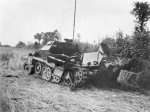
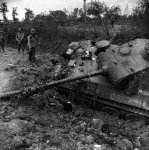
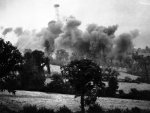

The British try to recover from Operation Spring, launched the day before. The losses were very high, which allows them to just hold their positions. The sacrifice of the Canadians helps the Allies achieve the goal of the Spring offensive: the Germans do not send divisions to reinforce the Cotentin peninsula, choosing instead to maintain a force in the south of Caen to counter possible further offensives. Spring is successful, but at catastrophic loss: 1,500 Canadians casualties.
On the eastern front, troops of the Soviet Leningrad Front capture Narva. To the south, Soviet 1st Belorussian Front captures Deblin and attacking into Seidlice. Soviet 1st Baltic Front attacking around Siauliai. Soviet 1st Ukrainian Front attacking German 1st Panzer Army around Przemysl. 1st Guards Army of Soviet 1st Ukrainian Front captures Stanislav.
In Italy, all quiet in zones of British 8th Army and US 5th Army. US 12th Air Force aircraft attack fuel dump, airfields, and enemy ground positions behind the front as well as transportation lines in the Po valley.
Pictured: A wrecked German SdKfz. 251 halftrack vehicle in Northern France, victim of USAAF 9th Air Force fighters, July 26, 1944; July 26, 1944. US soldiers searching for mines near a destroyed German tank just outside of Saint-Lo.; Thousand pound bombs explode near German lines during Operation Cobra in the Saint-Lô sector, July 26, 1944. This was the last picture taken by Associated Press war photographer, G. Bede Irvin, before he was killed by a bomb fragment. The film pack containing this picture was the only part of Irvin's equipment left intact by the bomb explosion and was sent from the front by a fellow photographer.; American soldiers near Saint-Lo, July 26th, 1944.




You know, if I didn't know what was going to happen shortly, I would think that the front was essentially stalled by the Germans, that the sacrifices were just too severe to be withstood...
There is a collector outside Daugavpils, Latvia who has a Sonderkraftfahrzeug in his garage. Pristine condition. He also has a T-34/85, a JS-2, an SU-100 and an SU-152, and some other vehicles. Just parked in his garage, unattended the day I visited. If you are in the neighborhood, I recommend it.Pictured: A wrecked German SdKfz. 251 halftrack vehicle in Northern France, victim of USAAF 9th Air Force fighters, July 26, 1944; July 26, 1944.
View attachment 3989
I really do not understand the German strategy. They were piecing together a defense in Normandy and their soldiers were fighting hard, inflicting a lot of casualties, but, in the long run, what were the ends, ways and means to win, or at least extract something other than unconditional surrender? Did the Germans really think they were going to attrit the Allies into giving up? Given the calamity befalling them in the East at that same time, I do not see any strategic thought besides "Fight harder." Thank goodness Hitler was a moron, I suppose.You know, if I didn't know what was going to happen shortly, I would think that the front was essentially stalled by the Germans, that the sacrifices were just too severe to be withstood...
I do not know (I'll have to check), but I bet the USAAF flew perpendicular to the German front lines, not parallel to them, just like they did on D-Day when they missed the beach defenses and pounded the crap out of the empty Norman fields behind the German defenses. Except in this screw-up, they dropped early, and killed a bunch of American soldiers including Irvin, McNair and a bunch of guys whose names we will never know.
Flying parallel to the German defenses means slightly greater risk to the aircraft from German AAA, but makes the bombing more effective. If you drop early or late flying parallel, you may not hit this German unit but you will hit that one. Flying perpendicular to the front minimizes the threat to the aircrew, but if you drop late, you are ineffective and if you drop early, you kill friendlies on the ground.
This was a failure of leadership on the part of Ike. He should have told the air planners, "I don't really care if parallel is riskier to the aircrews. Perpendicular is riskier to the infantrymen on the ground and their lives are hard enough already."
I realize Ike had the weight of the world on his shoulder, and made a bunch of good decisions, but this one was a screw-up. A repeat screw-up of his earlier mistake on D-Day.
I think with what was happening in the east he had little choice. There was pressure across the Allied front and we were pushing more men and gear into northern France 24/7.I really do not understand the German strategy. They were piecing together a defense in Normandy and their soldiers were fighting hard, inflicting a lot of casualties, but, in the long run, what were the ends, ways and means to win, or at least extract something other than unconditional surrender? Did the Germans really think they were going to attrit the Allies into giving up? Given the calamity befalling them in the East at that same time, I do not see any strategic thought besides "Fight harder." Thank goodness Hitler was a moron, I suppose.
IMO, the moment the Allies had a foothold in Normandy the western front was essentially lost, with the looming Dragoon as the death knell.
I think they had an inflated idea of the precision and effectiveness of their bombing, which they maintained tenaciously, despite evidence to the contrary...I do not know (I'll have to check), but I bet the USAAF flew perpendicular to the German front lines, not parallel to them, just like they did on D-Day when they missed the beach defenses and pounded the crap out of the empty Norman fields behind the German defenses. Except in this screw-up, they dropped early, and killed a bunch of American soldiers including Irvin, McNair and a bunch of guys whose names we will never know.
Flying parallel to the German defenses means slightly greater risk to the aircraft from German AAA, but makes the bombing more effective. If you drop early or late flying parallel, you may not hit this German unit but you will hit that one. Flying perpendicular to the front minimizes the threat to the aircrew, but if you drop late, you are ineffective and if you drop early, you kill friendlies on the ground.
This was a failure of leadership on the part of Ike. He should have told the air planners, "I don't really care if parallel is riskier to the aircrews. Perpendicular is riskier to the infantrymen on the ground and their lives are hard enough already."
I realize Ike had the weight of the world on his shoulder, and made a bunch of good decisions, but this one was a screw-up. A repeat screw-up of his earlier mistake on D-Day.
In the end, Hitler was not only a moron, he was a moronic corporal. I have nothing against enlisted at all. But there are good reasons not to make one your CiC. The rest of it is that Hitler had a psychological anomaly (and I won't drift off into present politics here) in that the boundaries between him and the Reich had become blurred. He and Germany were one and the same. At the end, he proclaimed that Germany had failed and didn't deserve to survive. He knew he was going to die - never would he be taken. So, the only time strategy was actually formed was the Bulge, which was always the longest shot possible. Another factor was his confidence in the German soldier and his contempt for the Allied soldiers, particularly the French contingent, admittedly small. He didn't feel the Americans and Canadians actually had a dog in the fight and would eventually fold under casualties. By this stage of the war, given the catastrophes in the east, he wasn't considering any kind of deal. It was go down anyway but go down fighting. Ike made mistakes, but the best thing which could have happened to the Allies was Hitler's micromanagement...I really do not understand the German strategy. They were piecing together a defense in Normandy and their soldiers were fighting hard, inflicting a lot of casualties, but, in the long run, what were the ends, ways and means to win, or at least extract something other than unconditional surrender? Did the Germans really think they were going to attrit the Allies into giving up? Given the calamity befalling them in the East at that same time, I do not see any strategic thought besides "Fight harder." Thank goodness Hitler was a moron, I suppose.
Found a pretty good article on the carpetbombing.I think they had an inflated idea of the precision and effectiveness of their bombing, which they maintained tenaciously, despite evidence to the contrary...
In 1944, U.S. Bombers Blasted Nazi Troops — And Accidentally Killed Scores of Americans
Lt Gen Pete Quesada (one of my heroes; I love that guy) had his 9th TAC Air Force bomb parallel. Bradley, for some reason, expected the heavies to come in parallel, and was angry when they did not.
Now, the Germans had 88mm cannons near the front. The 88 was a great anti-tank gun, but it was designed as an anti-aircraft gun, so not to be taken lightly. The 8th Air Force lost 5 (of 1,800) bombers or 0.3%. I would argue that, not only was bombing parallel more accurate and safer for the ground troops, I would say that flying perpendicular was more dangerous for the aircrews. You cannot just turn around a fleet of 1,800 aircraft on a dime, so they had to go deeper into German-control terrain, thus making them more susceptible to German AAA.
I have read that. At the end, Hitler wanted Germany punished for failing him. That was one heck of a punishment. That whole last year (May 1944-May 1945) was a massive bloodletting.In the end, Hitler was not only a moron, he was a moronic corporal. I have nothing against enlisted at all. But there are good reasons not to make one your CiC. The rest of it is that Hitler had a psychological anomaly (and I won't drift off into present politics here) in that the boundaries between him and the Reich had become blurred. He and Germany were one and the same. At the end, he proclaimed that Germany had failed and didn't deserve to survive. He knew he was going to die - never would he be taken. So, the only time strategy was actually formed was the Bulge, which was always the longest shot possible. Another factor was his confidence in the German soldier and his contempt for the Allied soldiers, particularly the French contingent, admittedly small. He didn't feel the Americans and Canadians actually had a dog in the fight and would eventually fold under casualties. By this stage of the war, given the catastrophes in the east, he wasn't considering any kind of deal. It was go down anyway but go down fighting. Ike made mistakes, but the best thing which could have happened to the Allies was Hitler's micromanagement...
True, but the ack-ack guns tended to be concentrated at the front...Found a pretty good article on the carpetbombing.
In 1944, U.S. Bombers Blasted Nazi Troops — And Accidentally Killed Scores of Americans
Lt Gen Pete Quesada (one of my heroes; I love that guy) had his 9th TAC Air Force bomb parallel. Bradley, for some reason, expected the heavies to come in parallel, and was angry when they did not.
Now, the Germans had 88mm cannons near the front. The 88 was a great anti-tank gun, but it was designed as an anti-aircraft gun, so not to be taken lightly. The 8th Air Force lost 5 (of 1,800) bombers or 0.3%. I would argue that, not only was bombing parallel more accurate and safer for the ground troops, I would say that flying perpendicular was more dangerous for the aircrews. You cannot just turn around a fleet of 1,800 aircraft on a dime, so they had to go deeper into German-control terrain, thus making them more susceptible to German AAA.
The failure to hit the large bunkers from the air, particularly at Omaha, and instead dumping the bombs behind the landing zones, for fear of hitting the landing forces, could have cost the entire invasion and did cost many lives. At Iwo Jima the Navy gave a good example of precision gunnery knocking out many of the bunkers that covered the landing beaches. The Marines also demonstrated close air support it ways that appears to me to be lacking in the ETO through to the end of the warI do not know (I'll have to check), but I bet the USAAF flew perpendicular to the German front lines, not parallel to them, just like they did on D-Day when they missed the beach defenses and pounded the crap out of the empty Norman fields behind the German defenses. Except in this screw-up, they dropped early, and killed a bunch of American soldiers including Irvin, McNair and a bunch of guys whose names we will never know.
Flying parallel to the German defenses means slightly greater risk to the aircraft from German AAA, but makes the bombing more effective. If you drop early or late flying parallel, you may not hit this German unit but you will hit that one. Flying perpendicular to the front minimizes the threat to the aircrew, but if you drop late, you are ineffective and if you drop early, you kill friendlies on the ground.
This was a failure of leadership on the part of Ike. He should have told the air planners, "I don't really care if parallel is riskier to the aircrews. Perpendicular is riskier to the infantrymen on the ground and their lives are hard enough already."
I realize Ike had the weight of the world on his shoulder, and made a bunch of good decisions, but this one was a screw-up. A repeat screw-up of his earlier mistake on D-Day.
I'm not that familiar with how the Japanese organized their beach defenses, but I have examined the Germans' Atlantic Wall. The Germans set their bunkers up to shoot obliquely along the beach, not at the beach perpendicularly. Viewed from straight out at sea, these bunkers were invisible or covered by thick concrete walls.The failure to hit the large bunkers from the air, particularly at Omaha, and instead dumping the bombs behind the landing zones, for fear of hitting the landing forces, could have cost the entire invasion and did cost many lives. At Iwo Jima the Navy gave a good example of precision gunnery knocking out many of the bunkers that covered the landing beaches.
On D-Day, the USS Emmons (DD-457) ran aground in an effort to get a 5 inch shell into one of the apertures of a German bunker. It worked. The Emmons put a 5" round into the aperture and blew out the left rear corner of that bunker from the inside. That probably did not do much good the German gun crew in that bunker.
A big part of that is having squadrons that belong to the Corps.These pilots know where their bread is buttered. Close Air Support is not a distraction from their job (which a lot of USAF fighter pilots believe it is). It is their raison d'etre.The Marines also demonstrated close air support it ways that appears to me to be lacking in the ETO through to the end of the war
July 27, 1944: It’s day three of the offensive code-named Operation Cobra - the front is finally opened to the southwest of Saint-Lo and the Americans now push to exploit it. At the west end of the opening, the 1st Infantry division and the 3rd Armored division push back the Germans of the 2nd and 17th SS Panzer Division to the village of Camprond, progress of almost 4 miles. In the center of the opening, the 2nd Armored division reaches the village of Notre-Dame-de-Cenilly, nearly 4.5 miles further to the south and reaches the Saint-Lo-Tessy-sur-Vire road at Mesnil-Opac. The town of Periers is finally liberated by the soldiers of the 90th Infantry division, and Lessay falls to the hands of the troops belonging to the 79th Infantry. Violent tanks battles are occurring between American armored divisions and isolated elements from the elite SS Panzer divisions "Das Reich" and "Götz von Berlichingen". SS-Oscha Ernst Barkmann, belonging to the 2nd SS Panzer Division "Das Reich", destroyed nine American Sherman tanks and several other vehicles of the 3rd Armoured division along the road connecting Saint-Lo to Coutances, close to the village of Lorey. But the Germans, despite having a higher fire-power with their tanks, are unable to slow down the irresistible American progress.
On the British front, it is a return to the battle for position. The brutal Operation Spring did not open the front in the south of Caen, but rather locked a maximum number of German divisions in the area so that they are not sent as reinforcements against the American divisions involved in Operation Cobra.
Above France, RAF Bomber Command sends 72 aircraft to attack V-weapons sites during the day while RAF 2nd Tactical Air Force conducts ground support missions, offensive sorties, and defensive patrols. US 9th Air Force bombers grounded, but fighters attack transportation lines and enemy ground positions in support of US 1st Army operations. US 8th Air Force attacks Gravelines with 20 bombers.
On the eastern front, Soviet forces advance. The 2nd Baltic (Yeremenko) captures Daugavpils in the north; 1st Baltic (Bagramyan) takes Siauliai; 2nd Belorussian (Zakharov) captures Bialystok; and 1st Ukrainian Front (Konev) takes Lvov and Stanislav 70 miles to the south.
In Italy, British 8th Army captures San Casciano. US 12th Air Force aircraft attack airfields and enemy ground positions behind the front as well as transportation lines in the Po valley.
Pictured: Private Sam J. Abbott of the US 1st Army Group maintains his position with a Browning machine gun during the start of the Allied breakthrough of German defensive positions, also known as Operation Cobra, on the Cherbourg Peninsula, France - 27 July 1944; A US 1st Army M8 HMC passes a Panther pushed off the road outside of Saint-Gilles on July 27, 1944. Note the hedge cutter (attached to the front of the M8) marked for censorship.; MP Lt. Paul Unger, 2nd Armoured Division, searching the POW SS-Untersturmführer Kurt Peters, III. in the area of Notre Dame de Cenilly of Saint Lô, France. July 27, 1944; Troops from the 17th Armored Engineers, 2nd Armored Division clear a lane blocked by debris in Canisy France, July, 27 1944
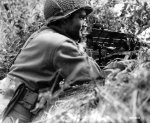
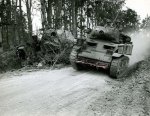


On the British front, it is a return to the battle for position. The brutal Operation Spring did not open the front in the south of Caen, but rather locked a maximum number of German divisions in the area so that they are not sent as reinforcements against the American divisions involved in Operation Cobra.
Above France, RAF Bomber Command sends 72 aircraft to attack V-weapons sites during the day while RAF 2nd Tactical Air Force conducts ground support missions, offensive sorties, and defensive patrols. US 9th Air Force bombers grounded, but fighters attack transportation lines and enemy ground positions in support of US 1st Army operations. US 8th Air Force attacks Gravelines with 20 bombers.
On the eastern front, Soviet forces advance. The 2nd Baltic (Yeremenko) captures Daugavpils in the north; 1st Baltic (Bagramyan) takes Siauliai; 2nd Belorussian (Zakharov) captures Bialystok; and 1st Ukrainian Front (Konev) takes Lvov and Stanislav 70 miles to the south.
In Italy, British 8th Army captures San Casciano. US 12th Air Force aircraft attack airfields and enemy ground positions behind the front as well as transportation lines in the Po valley.
Pictured: Private Sam J. Abbott of the US 1st Army Group maintains his position with a Browning machine gun during the start of the Allied breakthrough of German defensive positions, also known as Operation Cobra, on the Cherbourg Peninsula, France - 27 July 1944; A US 1st Army M8 HMC passes a Panther pushed off the road outside of Saint-Gilles on July 27, 1944. Note the hedge cutter (attached to the front of the M8) marked for censorship.; MP Lt. Paul Unger, 2nd Armoured Division, searching the POW SS-Untersturmführer Kurt Peters, III. in the area of Notre Dame de Cenilly of Saint Lô, France. July 27, 1944; Troops from the 17th Armored Engineers, 2nd Armored Division clear a lane blocked by debris in Canisy France, July, 27 1944




July 28, 1944: Operation Cobra has blown the western front wide open and the American forces work to take advantage. The US forces continue to exploit the opening of the front in the south of Cotentin under Operation Cobra. While the 2nd and the 3rd Armored divisions move to the south and southeast from the starting point of Operation Cobra, General Bradley’s 1st Army, positioned to the north of Periers, also pushes southward. The liberation of the towns of Lessay and Periers the day before make it possible for the US troops to join with two new armored divisions: the 4th and the 6th. The Germans pull back towards Coutances, which is reached by the 4th American Armored division that evening, having liberated the village of Saint-Sauveur-Lendelin on the way. The 4th Armored’s progression is rapid and the German opposition very weak - nearly 6 miles are gained today. The 84th German Corps is quickly pushed back - creating an unexpected opening - which the Allied forces take advantage of to progress towards Avranches.
While the American front has opened up and the Germans seem unable to stop them, the British do not manage any progress. The Germans are dug in to the south and east of Caen and do not move despite the mass of British and Canadians soldiers.
Over France, RAF Bomber Command sends 199 aircraft to attack V-weapons sites during the day followed by 119 aircraft to attack a V-weapons site overnight. US 9th Air Force bombers and fighters conduct missions in support of US 1st Army operations.
Over Germany, US 8th Air Force attacks Merseburg with 653 bombers and Wiesbaden with 57 bombers. US 8th Air Force bomber crews report sightings of Luftwaffe Me-163 rocket fighters. RAF Bomber Command sends 494 aircraft to attack Stuttgart, 307 aircraft to attack Hamburg, and 13 aircraft to attack Frankfurt overnight.
On the eastern front, Soviet 1st Belorussian Front is heavily engaged with German 2nd Army around Brest-Litovsk and Soviet 1st Ukrainian Front captures Przemysl.
In Italy, US 12th Air Force aircraft attack targets throughout Po valley.
Pictured: A French farmer from Notre Dame de Cenilly, France offers cider to American soldiers, July 28, 1944; US Reconnaissance Troops Advancing through Coutances, July 28, 1944; Map of the ‘Saint-Lo breakthrough’ from Operation Cobra. The progress in just a few day’s time has been dramatic.; Soviet mortar platoon firing on Army Group Centre near Baranovichi, July 28, 1944
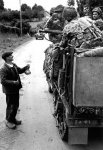
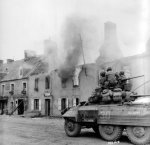
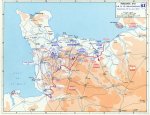

While the American front has opened up and the Germans seem unable to stop them, the British do not manage any progress. The Germans are dug in to the south and east of Caen and do not move despite the mass of British and Canadians soldiers.
Over France, RAF Bomber Command sends 199 aircraft to attack V-weapons sites during the day followed by 119 aircraft to attack a V-weapons site overnight. US 9th Air Force bombers and fighters conduct missions in support of US 1st Army operations.
Over Germany, US 8th Air Force attacks Merseburg with 653 bombers and Wiesbaden with 57 bombers. US 8th Air Force bomber crews report sightings of Luftwaffe Me-163 rocket fighters. RAF Bomber Command sends 494 aircraft to attack Stuttgart, 307 aircraft to attack Hamburg, and 13 aircraft to attack Frankfurt overnight.
On the eastern front, Soviet 1st Belorussian Front is heavily engaged with German 2nd Army around Brest-Litovsk and Soviet 1st Ukrainian Front captures Przemysl.
In Italy, US 12th Air Force aircraft attack targets throughout Po valley.
Pictured: A French farmer from Notre Dame de Cenilly, France offers cider to American soldiers, July 28, 1944; US Reconnaissance Troops Advancing through Coutances, July 28, 1944; Map of the ‘Saint-Lo breakthrough’ from Operation Cobra. The progress in just a few day’s time has been dramatic.; Soviet mortar platoon firing on Army Group Centre near Baranovichi, July 28, 1944




I did not know that U.S. Army GIs had been issued the camouflage patter shirt/tunic. I have seen Marines in the Pacific wearing something similar, but never in soldiers in Europe.
Photographic evidence is so valuable.
"A picture is worth a thousand words." The dying utterance of General George Armstrong Custer.
Staged photograph, probably for Krasnaya Zvezda (Red Star, the Soviet version Stars and Stripes.) (not that the Red Army did not fire tons of mortar rounds that summer. Clearly they did.).
The baseplate is not set. Once a mortar fires one round from a particular position, Newtonian physics takes over. Shoving a 3.1 kg 82mm mortar round out of the tube very fast shoves the baseplate firmly into the ground. That makes the fire round fairly inaccurate. Once the baselate is set and the mortar is "registered" (a test round fired to confirm the mortar's location on the map), the mortar becomes much more accurate.
Last edited:
Add me to the puzzlement. I have never, ever seen camo in the European theater...I did not know that U.S. Army GIs had been issued the camouflage patter shirt/tunic. I have seen Marines in the Pacific wearing something similar, but never in soldiers in Europe.
Photographic evidence is so valuable.
"A picture is worth a thousand words." The dying utterance of General George Armstrong Custer.
I suspect (with no direct knowledge other than how Germans think) that German anticraft guns were layered. The greatest threat to infantry and armor on the front lines was Allied fighter-bombers. So you place anti-aircraft machine guns and smaller (20mm) caliber cannons near the front lines. Further back, where the German had more stationary potential targets (ammo dumps, fuel depots), the Germans would place larger caliber anti-aircraft artillery like the 88mm cannons (I realize there were 88s on/near the front in the anti-tank role, but we're talking AAA).True, but the ack-ack guns tended to be concentrated at the front...
So, the solution is to bomb from a low altitude, just above 20mm maximum altitude (2200 m), but only just, and, to avoid the larger-caliber antiaircraft cannons that are deeper in German territory, German 88s that were being used in the anti-tank role would be deployed and sighted where they had the best field of fire for shooting Allied tanks, not for shooting aircraft, because the Allies did not use heavy bombers in the ground support role very often (Monte Casino, D-Day, and St. Lo being the only cases I am aware of).
- Status
- Not open for further replies.
Latest threads
-
SEC West Showdown Sends Alabama to Oxford to Meet with Ole Miss
- Started by Diamond Tide
- Replies: 0
-
Davis II Named to Stopper of the Year Midseason Watch List
- Started by Diamond Tide
- Replies: 0
-
Eleven-Run Third Powers Alabama to 14-5 Win over Samford
- Started by Diamond Tide
- Replies: 0
-
Maybe aTm's Pockets Aren't So Bottomless After All -- Layoffs In The Athletic Department
- Started by 4Q Basket Case
- Replies: 6
-
Time to un-vacate 2005-2007 on field victories and un-forfeit the 1993 season?
- Started by CmdrThor
- Replies: 24
-

